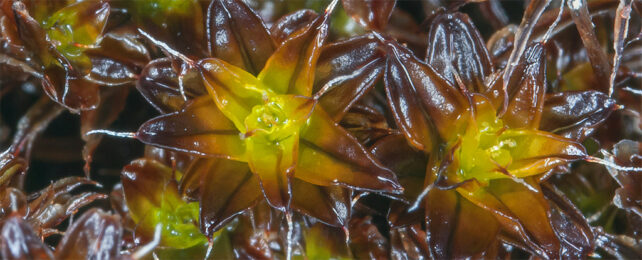
This all sounds like a bit of a stretch, but life does locate viable biomes that work we sure need to try.
Certainly we want to get there and build refugia to hold our cultivars. We want most of it to be underground as well. With power to provide grow lights.
That is what we are sure we can do. Natural biome engagement will be beneficial, at least long term.
This Plant Is So Extreme Scientists Think It Could Thrive on Mars
21 July 2024
Syntrichia caninervis. (John Game/Wikimedia Commons/CC BY 2.0)
Mosses are among Earth's great terraformers, turning barren rock into fertile soils, and now a team of scientists is proposing these non-vascular plants could do the same on Mars.
Whether we should introduce life from Earth onto our red neighbor is another question – we don't have a great track record with this on our own planet.
But if we decide it's worth messing with soil on Mars to create a second home for us Earthlings, ecologist Xiaoshuang Li and colleagues at the Chinese Academy of Sciences have a candidate that they think should do just the trick.
Earth's surface was once extremely inhospitable to life, but that didn't stop a group of organisms called the bryophytes – which today includes mosses, liverworts, and hornworts – from wrenching themselves out of the fertile safety of the oceans in search of new horizons.
The success of these terrestrial trailblazers hinged on their ability to harness and digest the nutrients that seep from or flow over rock, while surviving utterly hostile conditions that would reduce other living things to dust. But as they spread across Earth's rocky frontier they created soils, which paved the way for other less hardcore lifeforms to gradually step foot on dry land.
This genetic gumption continues to serve mosses across the world, and the researchers think we could harness their inbuilt talents to colonize Mars, laying the groundwork for other less-durable lifeforms, like crops.
Unlike the luscious forest mosses you might be picturing, which have it pretty easy compared to their ancestors, Syntrichia caninervis is committed to upholding a severely frugal way of life. It thrives in the deserts of China and the US, along with the icy mountains of the Pamir, Tibet, the Middle East, Antarctica, and circumpolar regions.
The Gurbantunggut Desert in northwest China is a hub for S. caninervis, which grows more densely here than anywhere else in the world, despite temperatures that range from -40 °C to 65 °C (-40 °F to 149 °F) and a relative humidity that gets down to 1.4 percent.
Li and colleagues put this moss to the test – and pushing S. caninervis out of its extraordinarily broad comfort zone is no easy feat.
In a lab, they tested the plant's responses to and recovery from extreme dehydration, prolonged freezing (-80 °C for 3 or 5 years, and -196 °C for 15 or 30 days), radiation (at doses of 500 to 16,000 Gy), and Mars-like conditions in the Chinese Academy of Sciences' Planetary Atmospheres Simulation Facility (PASF).
In the Mars simulation, the plants were subjected to pressures of around 650 pascals (Pa), similar to the 680–790 Pa on Mars. At night, the temperature was -60 °C, and during the day, 20 °C, which is equivalent to conditions on Mars in equatorial to mid-latitude regions. They also simulated the atmospheric gas composition and the ultraviolet radiation levels to be closer to those on Mars.
Dehydration was, for S. caninervis, a walk in the park. And in the extreme cold, it shrugged. All the frozen plants regenerated after defrosting, with plants that were dehydrated prior to freezing recovering much faster than their soggy peers.
In the face of radiation levels of 50 Gy that would kill humans, S. caninervis didn't blink an eyelid. At 500 Gy, its growth even seemed to speed up.
Mosses that had been dehydrated and then exposed to Martian-like conditions were able to act as if it never even happened after just 30 days' recovery. Their hydrated counterparts took a little longer to recover, but still lived to tell the tale.
"Although there is still a long way to go to create self-sufficient habitats on other planets, we demonstrated the great potential of S. caninervis as a pioneer plant for growth on Mars," the researchers write.
"Looking to the future, we expect that this promising moss could be brought to Mars or the Moon to further test the possibility of plant colonization and growth in outer space."
Even if moss on Mars turns out to be a terrible idea, the fact that S. caninervis can turn totally arid land into a 'living skin', even after surviving such extreme conditions, offers some hope for life on our own planet, which is, it seems, more resilient than we sometimes give it credit.
This research was published in The Innovation
No comments:
Post a Comment